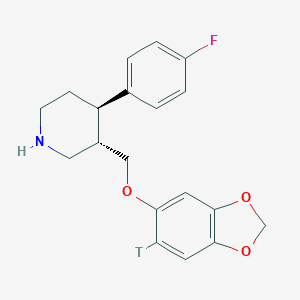Drug Information
| General Information | ||||||
|---|---|---|---|---|---|---|
| Drug ID |
DR00403
|
|||||
| Drug Name |
Paroxetine
|
|||||
| Synonyms |
(-)-(3S,4R)-4-(p-Fluorophenyl)-3-((3,4-(methylenedioxy)phenoxy)methyl)piperidine; (-)-(3S,4R)-4-(p-Fluorophenyl)-3-((3,4-methylenedioxy)phenoxy)methyl)piperidine; (-)-Paroxetine; (-)-trans-4-(4-Fluorophenyl)-3-(3,4-methylenedioxyphenoxymethyl)piperidine; (-)-trans-4-(p-fluorophenyl)-3-[[3,4-(methylenedioxy)phenoxy]methyl]-piperidine; (3S,4R)-3-(1,3-benzodioxol-5-yloxymethyl)-4-(4-fluorophenyl)piperidine; (3S,4R)-3-[(1,3-benzodioxol-5-yloxy)methyl]-4-(4-fluorophenyl)piperidine; (3S-trans)-3-((1,3-benzodioxol-5-yloxy)methyl)-4-(4-fluorophenyl)piperidine; (3S-trans)-3-[(1,3-Benzodioxol-5-yl-oxy)methyl]-4-(4-fluorophenyl)piperidine; 3-(Benzo[1,3]Dioxol-5-Yl-Oxymethyl)-4-(4-Fluoro-Phenyl)-Piperidine Hydrochloride; Aropax; BRL 29060; BRL-29060; Casbol; FG 7051; FG-7051; Frosinor; Motivan; NNC-20-7051; Paroxetina; Paroxetina [INN-Spanish]; Paroxetine (TN); Paroxetine (USP/INN); Paroxetine Hcl; Paroxetine [USAN:INN:BAN]; Paroxetinum; Paroxetinum [INN-Latin]; PaxPar; Paxetil; Paxil; Paxil (TN); Paxil CR;Seroxat CR; Pexeva; Seroxat; Seroxat (TN); [3H]Paroxetine
|
|||||
| Drug Type |
Small molecular drug
|
|||||
| Indication | Depression [ICD11: 6A8Z] | Approved | [1] | |||
| Therapeutic Class |
Antidepressants
|
|||||
| Structure |
|
 |
||||
| 3D MOL | 2D MOL | |||||
| Formula |
C19H20FNO3
|
|||||
| Canonical SMILES |
C1CNCC(C1C2=CC=C(C=C2)F)COC3=CC4=C(C=C3)OCO4
|
|||||
| InChI |
InChI=1S/C19H20FNO3/c20-15-3-1-13(2-4-15)17-7-8-21-10-14(17)11-22-16-5-6-18-19(9-16)24-12-23-18/h1-6,9,14,17,21H,7-8,10-12H2/t14-,17-/m0/s1/i5T
|
|||||
| InChIKey |
AHOUBRCZNHFOSL-RXMHWKDRSA-N
|
|||||
| CAS Number |
CAS 61869-08-7
|
|||||
| Pharmaceutical Properties | Molecular Weight | 331.4 | Topological Polar Surface Area | 39.7 | ||
| Heavy Atom Count | 24 | Rotatable Bond Count | 4 | |||
| Hydrogen Bond Donor Count | 1 | Hydrogen Bond Acceptor Count | 5 | |||
| XLogP |
3.5
|
|||||
| PubChem CID | ||||||
| PubChem SID | ||||||
| ChEBI ID |
ChEBI:7936
|
|||||
| TTD Drug ID | ||||||
| DT(s) Transporting This Drug | P-GP | Transporter Info | P-glycoprotein 1 | Substrate | [2] | |
| References | ||||||
| 1 | Paroxetine was approved by FDA. The official website of the U.S. Food and Drug Administration. (2019) | |||||
| 2 | Improving the prediction of the brain disposition for orally administered drugs using BDDCS. Adv Drug Deliv Rev. 2012 Jan;64(1):95-109. | |||||
If you find any error in data or bug in web service, please kindly report it to Dr. Yin and Dr. Li.
